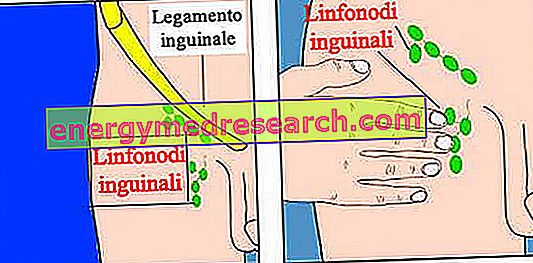Generality
The inguinal lymph nodes are the lymph nodes of the thigh that occupy the anatomical region known as groin.
Located below the inguinal ligament, they can be divided into two groups: the group of superficial inguinal lymph nodes and the group of deep inguinal lymph nodes.
The superficial inguinal lymph nodes reside just below the skin and are in all about ten; the deep inguinal lymph nodes, on the other hand, reside far below the skin, in a structure known as the femoral triangle, and can vary between 3 and 5 units.
The superficial inguinal lymph nodes receive the lymph coming from: genitals, lower abdomen, lower back, anus, perineum, buttocks, thighs and legs; therefore, they discharge it into the deep inguinal lymph nodes, which communicate, first of all, with the external iliac lymph nodes.
The enlargement of the inguinal lymph nodes may indicate the presence of an infection, a tumor, a systemic disease or the adverse effect of a drug treatment.

Image from the site www.bad.org.uk
Brief review of: lymphatic system, lymph and lymph nodes
The lymphatic system is that complex of organs and vessels having the task of collecting and eliminating the waste substances present in the tissues, hosting some cells of the immune system (B and T lymphocytes) and avoiding the excessive accumulation of fluids, in the tissues.
A substance called lymph flows in the lymphatic system. The lymph is a fluid derived from the blood, active participant of the functions of the lymphatic system.
Transparent in color, straw yellow or milky, depending on the case, the sap contains sugars, proteins, salts, lipids, amino acids, hormones, vitamins, white blood cells etc.
Lymph nodes ...
Lymph nodes are small organs of the lymphatic system, comparable to biological filters having the purpose of intercepting and destroying any germs, foreign substances and / or neoplastic cells, present in the lymph.
In the human body, the lymph nodes reside in strategic points, so that their action of monitoring and purification of the lymph is highly effective.
... AND OTHER LYMPHATIC ORGANS
In addition to the lymph nodes, the lymphatic system also includes other organs, which are: the thymus, the spleen and the bone marrow . The aforementioned organs are part of the lymphatic system, because they provide to produce and purify the lymph.
What are inguinal lymph nodes?
The inguinal lymph nodes are the lymph nodes that reside in the anatomical part of the thigh called the groin . To be precise, it is the lymph nodes located below the so-called inguinal ligament of the thigh.
The anatomy experts divide the inguinal lymph nodes into two groups: the superficial inguinal lymph nodes, located just below the skin, and the deep inguinal lymph nodes, located in the deepest subcutaneous tissues.
ANATOMICAL SEAT OF THE INGUINAL BOND
The inguinal ligament is that band of fibrous connective tissue, which, obliquely, extends from the so-called pubic tubercle of the pubis to the so-called anterior superior iliac spine of the ilium .
Pubic and ilium are, together with the ischium, the bony sections into which the iliac bone can be subdivided.
The iliac bone is the even and symmetrical bone which, together with the sacrum and coccyx, constitutes the skeletal structure of the pelvis called the pelvic girdle .
Anatomy
The superficial inguinal lymph nodes reside just below the inguinal ligament, at the same level as the anatomical region known as the femoral triangle (or Scarpa's triangle ). In front of them is the so - called Camper strip, while the femoral arterial vessels flow behind them.
The deep inguinal lymph nodes, instead, take place inside the aforementioned femoral triangle, in an area called the femoral canal . They occupy a medial position with respect to the femoral vein and lower than the so - called cribriform fascia .
WHAT IS THE FEMORAL TRIANGLE?
Resulting from the particular arrangement of the sartorius muscles, long adductor, pectineus and ileopsoas, the femoral triangle is a fossa located in the upper, anterior and medial part of the thigh, which encloses various structures, including: the femoral vein, the femoral nerve, the sheath femoral, inguinal lymphatic vessels and deep inguinal lymph nodes (NB: the inguinal lymphatic vessels and deep inguinal lymph nodes are located within the femoral canal).
Borders of the Scarpa triangle:
- Above, there is the inguinal ligament.
- Medially, there is the lateral border of the long adductor muscle.
- Laterally, there is the medial border of the sartorius muscle.

POSSIBLE SUBDIVISION OF SURFACE SURFACE LYMPHONODES
The anatomists considered it appropriate to subdivide the superficial inguinal lymph nodes into three subgroups : the lower inguinal lymph nodes subgroup, the supero-medial (or supra-medial) inguinal lymph nodes and the subgroup of the supra-lateral (or supra-lateral) inguinal lymph nodes .
Going into more detail:
- The subgroup of the inferior inguinal lymph nodes lies below the so-called saphenous opening of the thigh. The saphenous opening is a hole present on the fascia lata, through which passes a branch of the femoral vein, identified with the name of the great saphenous vein .
- The subgroup of the supra-medial inguinal lymph nodes takes place on the medial border of the saphenous opening.
- Finally, the subgroup of the supra-lateral inguinal lymph nodes occupy the lateral border of the saphenous opening.
HOW MANY SURFACE AND DEEP LYMPHONODES ARE?
In general, there are about 10 superficial inguinal lymph nodes, while the deep inguinal lymph nodes are between 3 and 5.
Function
The superficial inguinal lymph nodes receive the lymph that flows in the lymphatic vessels, coming from:
- Perineum;
- Buttocks;
- Abdominal wall, just below the navel;
- Back, approximately at the level of the iliac crest;
- Scrotum (in humans);
- Penile integuments (in humans);
- Vulva (in the woman);
- Anus;
- Thigh and medial side of the leg.
Therefore, they pour all their contents into the deep inguinal lymph nodes.
In addition to receiving lymph from the superficial inguinal lymph nodes, the deep inguinal lymph nodes receive the lymph coming from: the lower parts of the lower limbs, the clitoris (in women) and the penis (in men).
Once it has reached the deep inguinal lymph nodes, the lymph flows, first, into the external iliac lymph nodes, then, into the pelvic lymph nodes and, finally, into the paraortal lymph nodes.
| Subgroup of superficial inguinal lymph nodes | Origin of the afferent lymphatic vessels |
| lower | Thigh and medial side of the leg |
| I cross-media | Perineum, anus and external genitalia (thus scrotum, teguments of the penis and vulva) |
| Supero-side | Abdominal sub-umbilical wall, buttocks and part of the back located at the level of the iliac crest |
clinic
Because of the position they occupy, the inguinal lymph nodes are easily detected on palpation.
This makes them important from the clinical point of view, especially when it alleviates the suspicion of a medical condition that can lead to their enlargement.
pathology
In general, the lymph nodes are a signal of something wrong within the human body.
A swollen lymph node can be the consequence of something not particularly relevant, from a clinical point of view, and the consequence of something very serious.
The enlargement of the inguinal lymph nodes can have various causes, including: infections, tumors, particular pharmacological therapies, vaccines and systemic diseases.
INFECTIONS
Among the infections that can cause enlargement of the inguinal lymph nodes are:
- Sexually transmitted diseases, such as syphilis, gonorrhea, venereal lymphogranuloma, cancer (or venereal ulcer) and genital herpes;
- Viral infections, such as mononucleosis, an orchitis of viral origin, etc. Infectious diseases due to viruses cause a generalized enlargement of the lymph nodes of the human body. In fact, in addition to the inguinal lymph nodes, they can affect the lymph nodes of the neck, the axillary ones, etc.
- Bacterial infections affecting the skin and subcutaneous tissues, including muscles and bones.
- Toxoplasmosis . It is a generally asymptomatic infectious disease. When it is symptomatic, it is responsible for flu-like symptoms (headache, fever, myalgia, tiredness and sore throat). It is a particularly dangerous infection for people with a fragile immune system, such as AIDS patients.
Toxoplasmosis gondii is the cause of toxoplasmosis, a unicellular microorganism belonging to the protozoa sporozoa group.
- The bubonic plague . It is a particular bacterial infection, which, due to its importance and notoriety, deserves a separate treatment from other infections due to bacteria.
In addition to inducing an inguinal lymph node enlargement, it also causes an enlargement of the lymph nodes of the neck and armpit.
A cause of bubonic plague is a Gram-negative bacterium, called Yersinia pestis .
TUMORS
In the list of tumors that can cause enlargement of the inguinal lymph nodes, appear:
- Leukemias . Leukemias are malignant tumors of the blood that affect the white blood cell progenitor cells. White blood cells represent a part of the cellular component of blood; make up the immune system and their job is to defend the body from threats from outside and inside.
- Lymphomas . Lymphomas are malignant tumors that specifically affect the lymph nodes.
There are two types of lymphoma: Hodgkin's lymphoma and non-Hodgkin's lymphoma .
- Tumors to the pelvic organs and the possible consequent metastases . Tumors to the pelvic organs, which can induce an enlargement of the inguinal lymph nodes, are for example the tumor of the anus or the tumor of the vulva.
As a rule, the enlargement of the lymph nodes, due to the presence of a malignant tumor, is the signal that the malignant tumor in question has spread elsewhere, compared to the place of origin.
- Melanomas . A melanoma is a malignant tumor of the skin, which can cause the enlargement of neighboring lymph nodes.
DRUGS AND VACCINES
Enlarged inguinal lymph nodes can be a side effect of some drug therapies or some vaccines.
Among the drugs that can induce an enlargement of the inguinal lymph nodes (and not only), they deserve a mention:
- A drug indicated for gout, having the name of allopurinol ;
- Epilepsy drugs known as phenytoin and carbamazepine (NB: carbamazepine is also used in the treatment of bipolar disorder);
- Penicillin drugs, indicated for the treatment of some bacterial infections;
- Pyrimethamine, a drug with a specific action against malaria;
- Sulfonamides .
As far as vaccines are concerned, instead, trivalent vaccinations (against measles, mumps and rubella) and typhoid vaccinations could produce swollen lymph nodes.
SYSTEMIC DISEASES
Among the best known systemic diseases that can cause enlargement of several lymph nodes, including inguinal lymph nodes, are rheumatoid arthritis, sarcoidosis and systemic lupus erythematosus . It should be pointed out that these three conditions just mentioned tend to be associated with an enlargement of the inguinal lymph nodes, when they are at an advanced stage.
In children, a systemic disease that commonly causes an enlargement of the inguinal lymph nodes is lymphadenitis .



